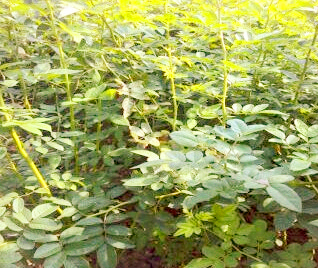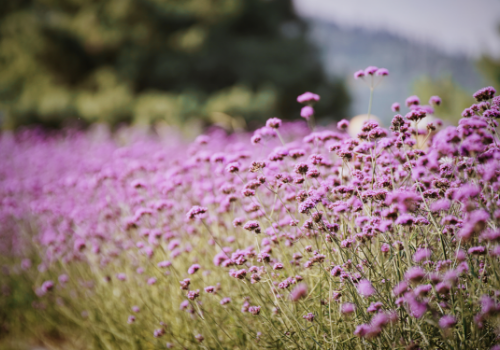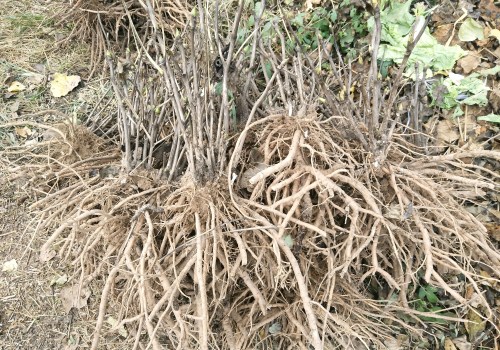Introduction to the planting method of rose "one of the world's famous ornamental plants"!
Rose is one of the world-famous ornamental plants, which has a long history of cultivation in China. Because of its fragrance and high ornamental value, it is liked by many people. Many people want to plant it, so the editor will introduce the planting method of rose to you.
First, sowing seeds
Sowing is usually carried out after autumn or spring sowing after sand storage. Soak the rose seeds in water for 1-2 days and mix them with 3 times wet sand. It is appropriate to hold the sand clumps and soak them without water. Then put the mixed sand seeds into a container and often keep them moist. This treatment is often carried out in winter. Before spring sowing, the seeds are screened for drying and sprinkled with water, and the seeds can be sowed until half of the seeds are cracked.
Second, watering
The watering of roses varies from season to season, and the winter dormancy period can keep the soil moist and dry, while before spring branches, the growth of branches and leaves can appropriately increase the amount of water, watering once every morning and evening, and it is necessary to increase the amount of water in the peak growing season and flowering period. during the summer high temperature, water evaporation increases plants in a weak semi-dormant state to avoid drying and dehydration, and water is watered once every morning and evening to avoid sun exposure. When watering at high temperature, each watering should have a small amount of water seeping out from the bottom of the basin, which means that it has been watered thoroughly. Do not splash water on the leaves to prevent disease.

III. Fertilization
Roses like fertilizer, and the base fertilizer is mainly based on delayed organic fertilizer, such as cow manure, chicken manure, bean cake and oil dregs. Adding liquid fertilizer and water every semimonthly can keep the leaves thick, dark green and shiny. Thicker liquid fertilizer can be applied before sprouting in early spring, and no fertilizer can be applied at flowering stage. Liquid fertilizer can be applied again after flower fade in June, and medium liquid fertilizer can be applied again when axillary buds will sprout for the fourth or fifth time in September. Overwintering with rotten organic fertilizer during the dormant period in December.
4. Pruning
Comprehensive pruning must be carried out after the first period of flowering in each season, it is generally appropriate to trim lightly and cut off the open residual flowers and thin overlapping branches in time, leaving stout and young branches, leaving only 3-6 cm from the base. leave the outer buds trimmed into a natural happy shape to prolong the flowering period, and potted roses should choose varieties with short, multi-flowered and rich aroma.
5. Disease prevention
Roses are easily infected with many diseases, and most of them are caused by fungi, such as powdery mildew, black spot, rust and so on. Pruning branches and leaves during peacetime maintenance is good for ventilation and ventilation. Before the occurrence of diseases and insect pests, liquid control can be sprayed to sterilize and disinfect. If diseases and insect pests have occurred, corresponding measures should be taken to avoid affecting the growth and flowering of roses.
Summary: the above is about the introduction of rose planting methods, growers can refer to the above planting methods to plant, hope to help friends in need!
Introduction to the breeding methods of Rose
Rose is one of the world-famous ornamental plants, happy to grow in the bushes by the roadside, by the field or in the hills. Wild roses are naturally distributed by streams, roadsides and garden sides, corners and other places, often dense and clustered, full of brilliant branches, light rain or morning dew, the petals are red and wet, the scenery is quite good, and it has high planting value. Let's take a look at the breeding methods of roses.
The planting time of the rose
The rose can be planted all the year round, keeping the root system moist in the growing season and preventing cold in winter, but it is suitable from autumn defoliation to spring sprouting, and the best planting period is from autumn defoliation to freezing. In order to make the plant grow and enlarge the flower cluster as soon as possible, large holes must be planted with 1 meter long and 1 meter wide, 0.6-0.8 meters deep, or digging planting ditches with 0.6-0.8 meters deep and 0.8 meters wide. Plant application of organic fertilizer, calcium superphosphate, mixed with the soil and concentrated application in the soil depth of 0.2 to 0.5 meters, after planting, timely irrigation.
Propagation methods of Rose
Rose seed can be used for raising seedlings, but it is easy to survive by using tender wood cuttings in the same year in production. Valuable varieties are difficult to cut and can be propagated by pressing or grafting. Seedlings of asexual reproduction can blossom in the same year. For the seedlings used as potted flowers, the older branches of fine varieties should be selected, the seedlings should be raised by striping method, and attention should be paid to pruning the main buds and artificial dwarfing. For seedlings used as cut flowers, varieties that can form mother branches and colorful flowers should be selected to raise seedlings. Roses can also be propagated by tissue culture, water culture, grafting, plantlet and so on.
Cultivation and Management of Rose
The main results are as follows: 1. Fertilization management: Rose likes fertilizer and tolerates barren. Liquid fertilizer dominated by nitrogen can be applied once or twice in March to promote the growth of branches and leaves. From April to May, fertilizers dominated by phosphorus and potassium are applied three times to promote more flowering of its poly-pregnant buds. After anthesis, there can be no more fertilization. Rose positive flowers, like warmth, but also hardy, North China and its south, can survive the winter outdoors safely.
2. Watering management: the rose is happy and moist and afraid of waterlogging. From budding to blooming, the water can be watered more appropriately, with the soil moist but not waterlogged as the degree, not too much watering after flowering, the soil should be dry and wet, and attention should be paid to drainage and waterlogging in the rainy season.
3, pruning: the rose has strong sprouting power and luxuriant growth. if it is not pruned in time, under the conditions of muggy, humid, lack of light and poor ventilation, diseases and insect pests are easy to occur, so a pruning should be carried out after flowering. When pruning, you can choose the sturdy branches that are semi-lignified in the same year, place them in the semi-shade, transplant them in the following spring after survival, or cut off the roots of the sprouting daughter plants before sprouting in early spring.
The above is Xiaobian to introduce to you the breeding method of rose, hope to be helpful to you!
Matters needing attention in the cultivation of Roses methods of propagation of roses
Rose is one of the world-famous ornamental plants, and it has a long history of cultivation in China. As far back as 1630 when Wang Xiang Jin wrote "Qunfang Spectrum", Chen Yuanzi wrote "Secret Flower Mirror" in 1688, and Wang Hao wrote "Guang Qun Fang Spectrum" in 1708, there have been records of roses, roses, roses and woody flowers. let's take a look at the rose culture methods and matters needing attention.
Propagation method of rose flower
Rose seed can be used for raising seedlings, but it is easy to survive by using tender wood cuttings in the same year in production. Valuable varieties are difficult to cut and can be propagated by pressing or grafting. Seedlings of asexual reproduction can blossom in the same year. For the seedlings used as potted flowers, the older branches of fine varieties should be selected, the seedlings should be raised by striping method, and attention should be paid to pruning the main buds and artificial dwarfing. For seedlings used as cut flowers, varieties that can form mother branches and colorful flowers should be selected to raise seedlings. Roses can also be propagated by tissue culture, water culture, grafting, plantlet and so on.
Matters needing attention of rose flowers
1. Anthracnose of rose flower
[symptoms] the plaque occurs at the edge of the leaf, semicircular, dark brown at the edge, brown to light brown in the middle, and small black spots on the plaque in the later stage. The pathogen overwintered on the diseased leaves. Under warm and humid conditions, spore germination invades leaves. The plant cluster is too dense and the moisture retention time is long, so it is easy to develop the disease. Anthracnose occurs sporadically and can be treated simultaneously in the prevention and treatment of black spot and leaf spot.
[prevention and control] clear the garden in time in late autumn and early winter, collect diseased fallen leaves and burn them. Strengthen maintenance, proper pruning, thinning too dense branches, so as to make good ventilation and light transmission. Spray 20% Longke bacteria (thiobacillus copper) suspension 500 times or 78% Cobo (wave) if necessary. Manganese and zinc) wettable powder 600x liquid, 75% Dakonine (chlorothalonil) wettable powder 600x liquid, 50% Shibaogong or Shibake (prochloraz) wettable powder 1000 times liquid, 25% carbon tetralin wettable powder 500x liquid.
2. Rose powdery mildew
[symptoms] the disease can occur in leaves, petioles, shoots and buds. There are irregular powdery mildew spots on the adult leaves, and the diseased leaves gradually turn brown from the tip or edge of the leaves, resulting in the drying and shedding of the whole leaves. Young leaves infected, chlorosis spread, gradually expanded, the edge is not obvious, young leaves on both sides of the white powder spots, and then covered with the whole leaf, the leaves become light gray or purplish red. The new leaves are wrinkled and deformed. After infected with petiole and new shoot, the internodes were shortened, the stem became thinner, some of the diseased shoots were withered, and the diseased part was also covered with white powder. The bud is infected, the bud and pedicel are covered with white powder, the calyx, petals and pedicels are deformed, and the serious ones wither and die, losing their ornamental value. Powdery mildew overwinters on diseased buds. Planting is too dense, nitrogen application is too much, poor ventilation, lack of sunlight, easy to develop.
[control] varieties resistant to powdery mildew were selected. When pruning in winter, pay attention to cutting off diseased branches and buds. The disease resistance was improved by applying less nitrogen fertilizer and more phosphorus and potassium fertilizer during the disease onset period. Pay attention to ventilation and light, timely drainage after rain, to prevent moisture retention, can reduce the incidence of disease. At the initial stage of the disease, 20% triadimefon EC 1000 times or 20% triadimefon sulfur suspension 1000 times and carbendazim wettable powder 1000 times were sprayed. If there is resistance to the above fungicides, 12.5% nitrilazole EC or 3000 times Teflin wettable powder can be sprayed instead. Spray Baume 2 / 3 stone sulfur mixture or 45% crystal stone sulfur mixture 40 / 50 times before sprouting in early spring to kill overwintering bacteria.
3. Roseflower beetle
[characteristics] Rose beetles mainly damage roots, leaves, buds and other parts, which seriously affect the yield and quality of flowers.
[prevention and control] Light trapping, willow trapping, oscillating trapping, etc. When the damage is serious, 2.5% deltamethrin 2000-3000 times or 50% phoxim 1000-1500 times can be sprayed. The effect is good, but it must not be sprayed at flowering stage.
- Prev

How much is the price of lavender seeds in 2019? What are the prospects for growing lavender?
Lavender, also known as spirit vanilla, yellow vanilla, known as the king of spices in nature, has high medicinal value, beautiful and elegant flowers, and high ornamental value. So, what is the price of lavender seeds in 2019? What are the prospects for growing lavender? Lavender seed price, there are many varieties of lavender.
- Next

How much is the price of oil peony seedlings? Are there any prospects for planting in 2019?
Oil peony is a woody oil crop, which can produce peony seed oil. at present, there are only two varieties, namely Phoenix peony and purple spot peony, with oil content above 20%. Because of its high yield and high efficiency, many people want to plant it. So, how much is the price of oil peony seedlings?
Related
- Fuxing push coffee new agricultural production and marketing class: lack of small-scale processing plants
- Jujube rice field leisure farm deep ploughing Yilan for five years to create a space for organic food and play
- Nongyu Farm-A trial of organic papaya for brave women with advanced technology
- Four points for attention in the prevention and control of diseases and insect pests of edible fungi
- How to add nutrient solution to Edible Fungi
- Is there any good way to control edible fungus mites?
- Open Inoculation Technology of Edible Fungi
- Is there any clever way to use fertilizer for edible fungus in winter?
- What agents are used to kill the pathogens of edible fungi in the mushroom shed?
- Rapid drying of Edible Fungi

